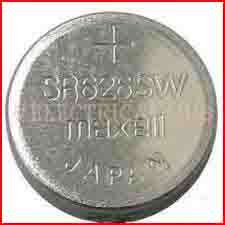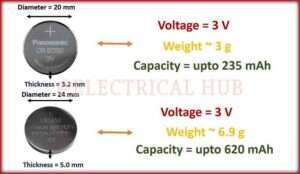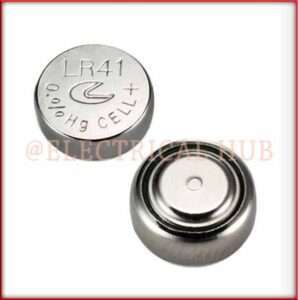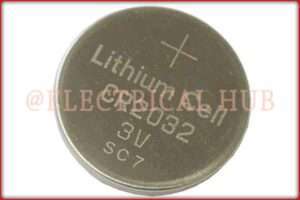LR41 Battery Specifications & Equivalent: A Comprehensive Guide
The LR41 battery, known interchangeably as AG3, 392A, or SR41, stands as a compact yet robust button cell battery extensively utilized in a wide array of small electronic devices. This petite cylindrical power source operates at a voltage of 1.5 volts, serving as the backbone for gadgets such as watches, calculators, small toys, laser pointers, and even certain medical instruments.
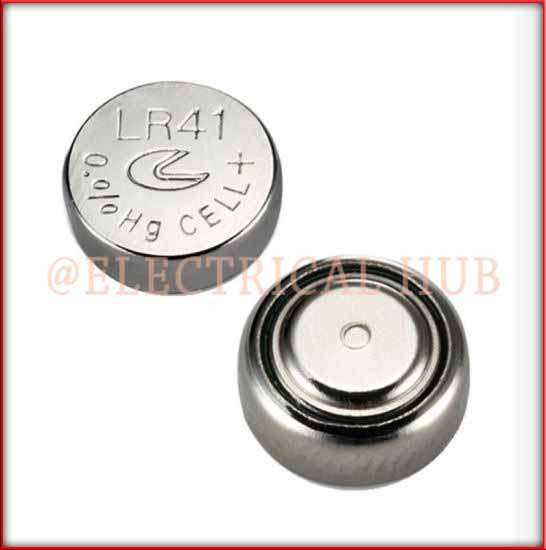
Its diminutive size, coupled with a consistent and dependable energy output, has firmly established the LR41 battery as a cornerstone in the domain of low-drain electronic devices.
Read More About
Technical Specifications of LR41 battery
We often know the LR41 battery by names like AG3, 392A, or SR41, and these names refer to specific technical specifications crucial for performance and usage:
Voltage: We can count on the LR41 battery to consistently deliver a steady 1.5 volts. This voltage perfectly suits the needs of low-drain devices, ensuring they operate reliably and consistently.
Dimensions: The LR41’s design boasts a compact size, approximately 7.9 millimeters in diameter and 3.6 millimeters in height. This design allows it to seamlessly integrate into devices tailored for this specific form factor.
Capacity: While not a high-capacity cell, the LR41 battery offers a moderate capacity with a consistent voltage output, making it an ideal power source for low-drain gadgets.
Equivalent Names: Whether it’s AG3, 392A, or SR41, these different labels refer to the same reliable battery across various manufacturers, ensuring compatibility.
The LR41 battery’s technical specifications make it a dependable power source for smaller devices requiring steady and moderate energy levels. Its compact design, stable voltage output, and compatibility with low-drain electronics, such as watches, calculators, small toys, and medical instruments, make it a popular choice.
Chemistry of LR41 Battery
The LR41 battery, also known as AG3, 392A, or SR41, relies on alkaline chemistry to generate power. This chemistry involves specific components that enable the battery’s functionality:
Inside the LR41 battery, the anode consists of zinc while the cathode comprises manganese dioxide. The electrolyte, which enables ion flow, typically contains potassium hydroxide.
During discharge, oxidation of zinc within the anode releases electrons that power the device. Simultaneously, the cathode’s manganese dioxide reacts with hydroxide ions and electrons, forming water and manganese oxide.
Alkaline chemistry, used in the LR41 battery, ensures a reliable and moderate power supply, suitable for various low-drain devices. However, it’s important to note that LR41, like other alkaline batteries, operates on a non-rechargeable basis due to the irreversible chemical reactions occurring within.
The choice of alkaline chemistry in the LR41 battery strikes a balance between longevity, cost-effectiveness, and stable power output, making it practical for powering numerous small electronic devices requiring dependable and consistent energy.
Where to Buy?
[wptb id=11565]LR41 Battery vs SR41
LR41 and SR41 batteries share similar size and designations, but they differ in some aspects:
LR41 Battery:
- Voltage: 1.5 volts
- Commonly known as AG3, 392A, or LR41
- Typically uses alkaline chemistry
- Often used in low-drain devices like watches, calculators, and small toys
- Moderate capacity, suitable for devices with modest power needs
SR41 Battery:
- Voltage: 1.55 volts
- Also referred to as AG1, 364, or SR41W
- Usually utilizes silver oxide chemistry
- Commonly used in watches, calculators, and various small electronics
- Slightly higher voltage compared to LR41 but usually physically compatible in most devices
While these batteries share similarities and can sometimes be interchangeable, the voltage difference might affect certain electronics. Checking the device’s specifications or manual ensures using the correct battery type for optimal performance.
Lifespan of LR41 Batteries
The longevity of LR41 batteries depends on several factors:
- Device Usage: Frequent use drains the battery faster.
- Device Type: Low-drain devices make LR41 batteries last longer.
- Storage Conditions: Extreme temperatures or humidity affect battery life.
- Battery Quality: Higher-quality batteries tend to last longer.
In typical low-drain devices, LR41 batteries can last several months to a couple of years. Infrequently used devices may extend their lifespan. However, high-drain devices might shorten battery life to a few weeks or months. Regularly monitoring device performance and replacing LR41 batteries as needed helps maintain optimal functionality.
The equivalent of LR41 Battery
The LR41 battery is known by several alternative designations or equivalents such as AG3, 392A, SR41, LR736, and LR41W. These different labels are interchangeable and serve as references across diverse manufacturers and geographical areas.
They denote the same type of battery, ensuring compatibility and enabling the powering of a diverse range of small electronic devices. This interchangeability allows users to find the right power source regardless of the naming conventions used by different manufacturers, ensuring seamless functionality across various gadgets.
Subscribe to our Newsletter “Electrical Insights Daily” to get the latest updates in Electrical Engineering. You can also Follow us on LinkedIn and Facebook to see our latest posts on Electrical Engineering Topics.
Worth Read Posts
- LR44 Battery
- CR123 Battery
- Lithium Ion Batteries
- CR2032 Battery
- Methods of Electrical Earthing
- Electrical Earthing Important Types
- Plant Factor, Plant Capacity Factor, and Load Factor
- Buck Converter Interview Questions
- DC DC Converter Interview Questions
- Transformer Electrical Interview
- Top 30 Op Amp Interview Questions
- Power Electronics Interview Questions
What is an LR41 battery?
An LR41 battery is a button-cell alkaline battery. It is a small, cylindrical battery with a diameter of 7.9 mm and a height of 3.6 mm. LR41 batteries are commonly used in various small electronic devices, including watches, calculators, and medical instruments.
What are the specifications of an LR41 battery?
The typical specifications for an LR41 battery are:
Voltage: 1.5 volts
Chemistry: Alkaline
Diameter: 7.9 mm
Height: 3.6 mm
What are the equivalents of LR41 batteries?
LR41 batteries have several equivalent designations, including:
AG3
G3
192
392A
SR41
LR736
L736
CX41
RW87
384
Where are LR41 batteries commonly used?
LR41 batteries are commonly used in small electronic devices, such as:
Watches
Calculators
Laser pointers
LED flashlights
Medical instruments
Hearing aids
Toys
Can LR41 batteries be replaced with other equivalents?
Yes, LR41 batteries have equivalents like AG3, G3, 192, and others. However, it’s crucial to match the voltage and size requirements of the original battery to ensure proper functioning.
How long do LR41 batteries typically last?
The lifespan of LR41 batteries depends on factors like usage and the power requirements of the device. In low-drain devices, LR41 batteries can last for several months to a few years.
Can LR41 batteries be recharged?
LR41 batteries are typically non-rechargeable alkaline batteries. Attempting to recharge them can be dangerous and may result in leakage, overheating, or other issues. It is recommended to use rechargeable batteries for devices that require frequent replacement.
Are LR41 batteries the same as LR44 batteries?
No, LR41 and LR44 batteries are different in size and voltage. LR41 batteries are smaller and have a voltage of 1.5 volts, while LR44 batteries are larger with a voltage of 1.5 volts as well. They are not interchangeable.
Can LR41 batteries be recycled?
Yes, LR41 batteries can be recycled. Many recycling facilities accept alkaline batteries for proper disposal. It’s essential to follow local recycling guidelines to ensure proper handling.
What precautions should be taken when handling LR41 batteries?
When handling LR41 batteries, avoid short circuits, overheating, and puncturing. Store them in a cool, dry place, and follow the manufacturer’s guidelines for proper usage and disposal.
Can LR41 batteries be used in high-drain devices?
LR41 batteries are generally suitable for low to moderate drain devices. Using them in high-drain devices may result in reduced lifespan and performance. It’s advisable to choose a battery type appropriate for the device’s power requirements.
How can I prolong the life of LR41 batteries?
To extend the life of LR41 batteries:
Store them in a cool, dry place.
Remove batteries from devices that won’t be used for an extended period.
Use the right type of battery for the device’s power requirements.
Avoid mixing old and new batteries.
Are there rechargeable versions of LR41 batteries?
While LR41 batteries are typically non-rechargeable, there are rechargeable alternatives available, such as AG3 rechargeable batteries. These rechargeable equivalents may have a slightly lower voltage (1.2 volts) compared to the non-rechargeable LR41 (1.5 volts).
What should I do if an LR41 battery leaks?
If an LR41 battery leaks:
Wear gloves and avoid direct contact with the leaking material.
Remove the battery carefully using non-metallic gloves or tools.
Clean the affected area with a mild acid like vinegar.
Properly dispose of the damaged battery and clean any corrosion.
Can LR41 batteries be used in outdoor or extreme temperature conditions?
LR41 batteries perform best in moderate temperature conditions. Extreme heat or cold may affect their performance. It’s recommended to store and use them within the specified temperature range provided by the manufacturer.
Are LR41 batteries safe for air travel?
LR41 batteries are generally considered safe for air travel, especially when installed in devices. However, it’s advisable to check airline regulations and guidelines regarding the transportation of batteries in carry-on or checked luggage.
How do I know when an LR41 battery needs replacement?
Signs that an LR41 battery may need replacement include diminished power in the device, reduced brightness (in the case of lights), or erratic device behavior. If you notice these signs, it’s time to replace the battery.
Can LR41 batteries be used in high-precision devices?
LR41 batteries are suitable for many low-drain devices. However, in high-precision devices that require a stable and consistent power supply, it’s advisable to consult the device’s specifications and, if needed, use batteries specifically recommended by the manufacturer.
Subscribe to our Newsletter “Electrical Insights Daily” to get the latest updates in Electrical Engineering. You can also Follow us on LinkedIn and Facebook to see our latest posts on Electrical Engineering Topics.

